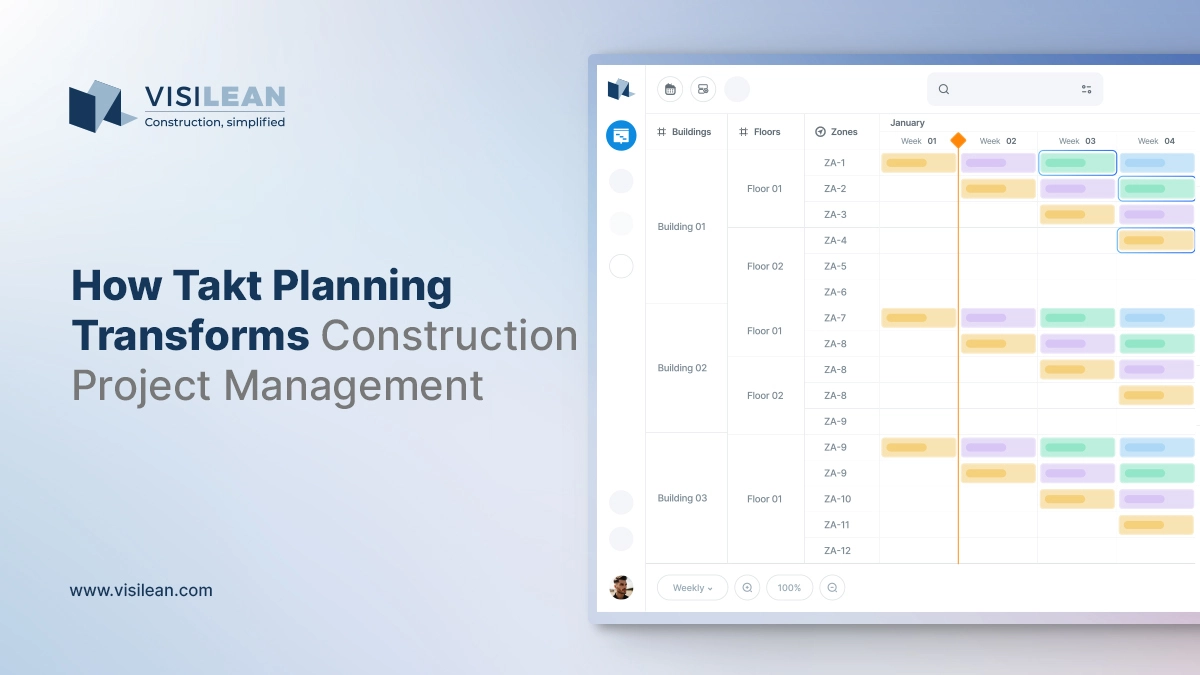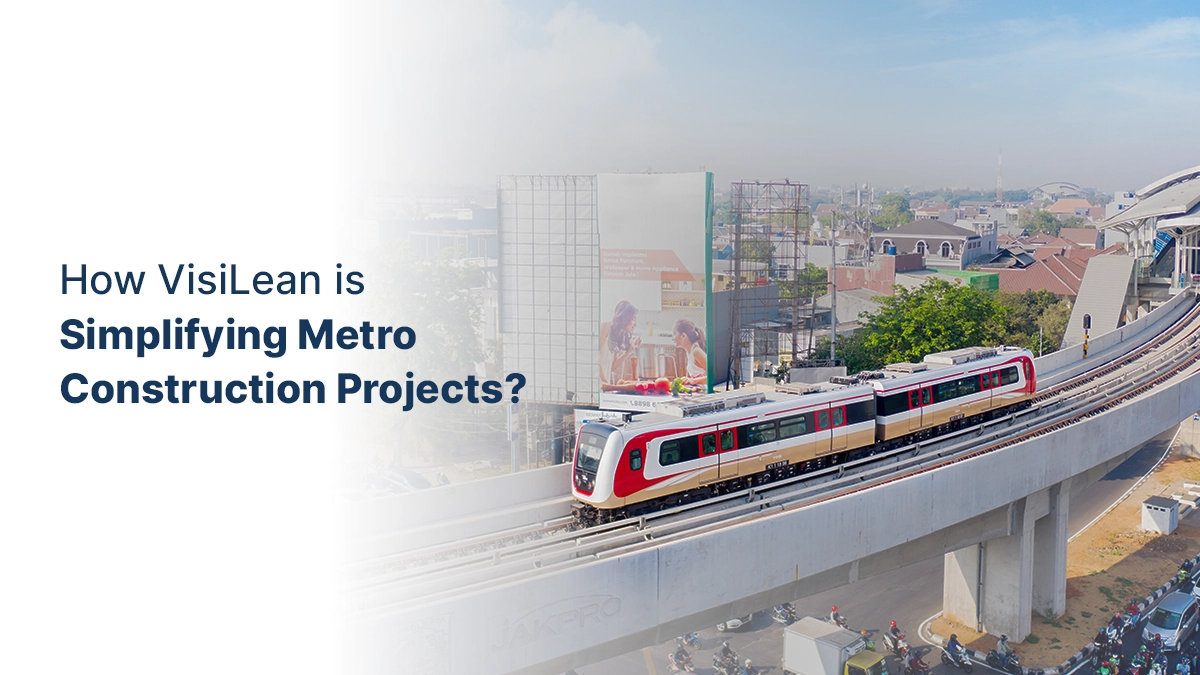The end of the last decade left the whole world with scars we are still recovering from. Amongst all affected, the AEC industry has taken a huge hit from the global pandemic, with projects across the globe still struggling to see a significant scope of revival. The cumulative impact of the supply chain, funding, and a global crisis has snowballed and left the industry in a state of stalled project sites with no clear prospects of growth. The industry status quo is making one thing evident – digitalisation of construction is becoming an absolute necessity!
The major impact of this global pandemic on the construction industry is the limitations offered by our existing practices. Our project workflows are primarily manual in nature, requiring a lot of physical involvement of teams. While execution does happen at the ground level, our supporting processes, which see the projects develop from design to handover, have significant scope in digitalisation.
The construction management process is plagued with wastes in the industry, which can be minimised significantly by introducing digital tools. There are tools for practically every aspect of construction, and every phase of construction project delivery.
Read more about the COVID outlook of the industry – reviewing the status quo here.
Digital Construction
There has been a lot of talks in the industry recently about digital construction, digitisation, digitalisation, modularisation, technological innovation, Construction 4.0, and so on. While you must have come across some of these, there is still a big question mark as to how one can take the first steps towards a digital approach to construction; and this question is becoming more and more relevant in this decade.
It is not that hard to imagine why; construction predominantly has always been looked at to be fragmented, ad-hoc, and chaotic, with constant firefighting at the site level. It is difficult to imagine a high level of dependency on technology when we are so used to counting on our teams for information, updates, reports, master plans, phase plans, execution plans, and so on.
The problem is when we start to think of digitalisation as a replacement, while in fact, it is an enabler.
Your teams are still the ones that need to do the work on-site, the same people need to design the project, get it ready for execution, develop it, and hand over it; the technology simply enables the development and execution of the projects for better.
In the simplest terms – digitalisation will help reduce workhours spent by your teams in doing non-value adding activities which can be better utilised to design the project, plan the construction in greater detail, execute the project at site more efficiently while ensuring quality, and report on issues at the right time so corrective action can be taken immediately.
Read more about the limitations of existing construction workflows – the biggest waste in construction – reporting.
An Industry Overview
Globally, our industry has gone through immense digital transformation over the past two decades. Certainly, the experience of switching from hand drafting to AutoCAD® is a vivid memory in the industry’s mind.
Today, we have digital tools supporting each phase of construction project delivery across each vertical and addressing each stakeholder. We have digital solutions enabling Lean practices, BIM-based design development, Integrated Project Delivery, Big Room approach, and so on. With Industry 4.0, we are now talking about completely automated systems of systems essentially!
While industrialisation might be progressing towards complete integration and automation, construction surely seems to be lagging.
How far behind?
Well, the answer is evident in 90% of our construction sites across the globe; we are still glued to manual, extensive physical processes, leading to a staggering amount of non-value-adding time spent in construction project delivery.
- Design development still follows a silo-based approach; project consultants are introduced well into the detailed design stages
- Project brief and client requirements are not clearly defined or communicated
- Contractors still follow top-down project planning without factoring execution-related site-based constraints; there is very minimal collaboration in construction planning.
- Communication is still limited to word-of-mouth, endless reports, and emails.
- Documentation and reporting are plagued with human intervention and extra processing, leading to critical time being spent on non-value-adding activities
Collaboration is practically missing, and hence, improvement is a dream, and cost and time overruns are the industry norm.
Industry Challenges
Construction is complex, highly fragmented, and extremely uncertain. With designs undergoing constraint rework and multiple revisions, unrealistic project schedules being dictated and pushed down to the site, and construction project managers mediating between teams and filtering information between the site and head office, the teams on-site responsible for execution are left with no clarity about the work to be done.
This entire process is plagued with latency, lack of clarity, poor communication, and practically no collaboration between teams. With teams running in circles around the same problem at the core, construction projects end up running in an endless loop of delays and cost overruns.
As a team delivering one product, one reality, we are still not clear about the concept of value. Not acting at the right time causes delayed actions, leading to consecutive site issues piling up and turning into critical problems that affect project delivery.
Digital tools and their role in Construction
With this new decade bringing immense pressure for sustainable and smart development, can we still continue with conventional practices of construction project management?
The answer is no, and the industry is starting to show that with the significant increase in construction project management software, digital construction experts, and Lean and digital construction consultants across the globe.
Digitalisation comes in numerous forms when we talk of construction project delivery. The need, however, is that we try and skip heavily manual processes in our workflows, to simplify the flow of information and data amongst our teams.
81% of the industry believes that believe digitization will improve the productivity of the construction sector.
David Bain. NBS. 2020. NBS BIM Report, 2020.
Information is key
The key to delivering successful projects is information, providing the right information to the right people at the right time so the right decisions can be taken. From critical design decisions to defining project execution strategies, having accurate and reliable information can help teams decide the best course of action for achieving valuable project results.
Digital tools play a key role in achieving this. With Building Information Modeling (BIM), designers and consultants can collaborate in the cloud for real-time access to the latest designs, run clash detection to ensure minimum rework at the site, and even coordinate design changes with complete clarity amongst all stakeholders.
This information populated in the BIM model can help Construction Planners develop execution strategies that suit the design, defining the Phase Plan and key Milestones to be achieved. This approach further enables the integration of design and execution, which can ensure minimal rework on site and efficient handovers, amongst overall work clarity.
Enabling Collaboration
The Last Planner® System of collaborative planning allows teams to participate in planning decisions and map any potential constraints. However, the conventional sticky notes approach to collaborative planning poses major limitations for complex projects, with teams struggling to manage and keep track of the paper trail.
Again, technology plays a critical role here, allowing for construction phase plans to be visualised by teams to pull the look-ahead work packages in detail, with constraints that can be logged and tracked on a common platform across the project. With work clarity comes clear communication and transparency between teams, which helps build trust – an essential factor for successful project realisation.
By providing the teams with a common platform and the information to collaborate, commit, review, and act, you reduce the blame game and instead focus on performance improvement areas.
Adopting a proactive rather than reactive approach
With digitalisation enabling transparency and providing teams with crucial information, the project has started to adopt a proactive approach, with teams managing to map and resolve issues and make decisions rather than reacting after the fact.
Teams start to adopt a make-ready approach (another Lean principle, part of the LPS tool), ensuring the prerequisites are in place before commencing with the job to be executed. This allows for preparation time and work clarity and ensures teams dependent on each other are responsible for their handovers.
Construction Technological Advancements
With numerous construction project management solutions in the industry, there is a digital application for each phase of project delivery. Let us take a closer look at which ones will play a key role as we enter the decade with 2021 marking the absolute need for digitalisation in construction today!
Design Development
Technology is now integrated deep within the design process. While Generative Design can help review multiple design alternatives based on defined parameters, Augmented Reality and Virtual Reality can help teams and clients visualise the space with an almost realistic accuracy.
Reality capture can now provide us with an accurate digital representation of any physical object, even a 200-year-old building, or help review as-built against the design developed. Before you decide on your cladding or glazing systems, energy simulations can be conducted to understand the impact of your design on the habitable spaces of your facility.
Solutions integrating design and execution workflows can help conduct constructability and value-engineering reviews. Structural, time, and cost simulations can provide powerful visualisation that helps forecast work and cost flow.
Production Planning
Information empowers proactive planning and decision-making. AI-based scheduling is now pushing the boundaries of planning based on conventional factors; site and project-specific data can now populate your plans and reschedule according to what is best suited for you!
4D simulations and clash detection help pre-empt issues during execution, the visualisation capability of which can be amplified further with AR/VR. Location-based information can layer over such simulations for detailed review at a micro-level.
Sensors across the industry can provide essential supply-chain information through automated updates, thereby making resource planning more reliable.
Production Control
Real-time information is key to establishing control over construction project delivery. This information can be provided live from sensors across your site, from your teams, equipment, and even locations. Your systems, capable of learning from this information, can then provide you with strategies for improvement!
Performance review becomes a step easier and more accurate, with real-time productivity information coming directly from the site. With the right IoT (Internet of Things) platform, your teams will be able to harness all this information towards continuous improvement.
Reality capture has now pushed the boundaries of progress review – you can watch your site live from anywhere across the globe with robots, drones, or 360 cameras feeding real-time photographic data to your systems. Hourly, daily, or weekly reviews make progress visualisation as realistic as visiting the site.
Facilities Management
Advanced technology is supporting project delivery across the life cycle. With BIM-enabled as-built modelling and asset tagging, facilities are now live, with information being supplied through every system. Monitoring system operations can greatly help the facility management team, for instance, by reducing electricity and water consumption based on accurate occupancy data.
With systems well integrated within your facilities’ services, AR tools can help visualise plumbing behind walls, thereby making it much simpler for teams to conduct service routines. Asset information can help keep a check on when the next service is due, or when the asset needs to be replaced.
With clear requirements laid out during the design development stage, planning for facility management can be done at the right time, ensuring all the information can then be harnessed during operations and maintenance.
Off-site Construction
If we can take some of our construction off-site and start “manufacturing” in controlled environments, we can boost productivity considerably while also ensuring the highest safety standards for our teams deployed.
This, too, is supported by digitalisation, wherein you can plan, monitor, and track the production remotely. With inherent benefits to manufacturing part of your construction off-site, advanced tools can immensely amplify the impact of such a workflow. RFID tags can help track your modules from manufacture to installation on-site. With accurate location mapping, the modules can be installed with precision and agility.
Digital Construction – The need-of-the-hour
Construction Projects are Complex
Construction is messy, chaotic, complex, and extremely unpredictable. Let us embrace the challenges one at a time and deploy appropriate solutions along with reviewing our workflows to better suit our projects and teams and deliver valuable projects as an industry.
From drones and robots to simple photos clicked from a mobile phone, there is immense scope for digitalisation across the construction industry today. However, it is important to understand first what is appropriate for you. It is essential to begin somewhere and to take the right first steps which will enable a wider acceptance amongst your teams.
Start with a review of your existing processes, understand your team and their requirements, address the pain points, and take the first steps. But start, start today.
Just Digital?
Did the terms flow, waste, value, and continuous improvement mentioned earlier, sound familiar? Well, digitalisation alone is not the solution here. In times where acclimatisation to the “new normal” itself is a big challenge, exploring new opportunities always takes a backseat, and changing behaviour and mindsets often become a bigger roadblock.
This is where, Lean processes can help enable this transition based on the right alignment of tools and practices deployed, along with the cultural setting of your teams. A top-down approach to the deployment of solutions is hardly ever successful in penetrating the organisation.
VisiLean – The Digital Construction Management Solution
With VisiLean, we address the heart of construction production management. With dedicated modules to digitalise your production planning, monitoring, and tracking and the right set of tools to provide production control, VisiLean helps you transition seamlessly towards Lean digitalisation. With dedicated support and excellent system interoperability, we respect your teams’ familiarisation with existing platforms and workflows, promising smooth onboarding and transition across the organisation, one step at a time.
If you want to take the first steps towards digitalisation and save significant time and cost on your construction projects, sign up for a fully featured free demo at VisiLean – https://visilean.com/demo-page/
Want to know more about us? Head to https://youtu.be/vALoybf0zpM, or visit our website, https://visilean.com, to learn about all our features!





